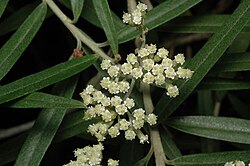Biology:Ozothamnus stirlingii
| Ovens everlasting | |
|---|---|

| |
| Scientific classification Error creating thumbnail: Unable to save thumbnail to destination
| |
| Kingdom: | Plantae |
| Clade: | Tracheophytes |
| Clade: | Angiosperms |
| Clade: | Eudicots |
| Clade: | Asterids |
| Order: | Asterales |
| Family: | Asteraceae |
| Genus: | Ozothamnus |
| Species: | O. stirlingii
|
| Binomial name | |
| Ozothamnus stirlingii (F.Muell.) Anderb.[1]
| |
Ozothamnus stirlingii, commonly known as Ovens everlasting,[2] is a flowering plant in the family Asteraceae and grows in New South Wales, Victoria and the Australian Capital Territory. It has globose-shaped white flower heads and sticky leaves.
Description
Ozothamnus stirlingii is a shrub to 3 m (9.8 ft) high with covered in short, matted hairs. The leaves are elliptic to lance-shaped, 65–80 mm (2.6–3.1 in) long, 10–13 mm (0.39–0.51 in) wide, upper surface dark green, smooth and sticky. The lower surface is light green or white, sticky, covered with a dense covering of short, matted hairs and on a petiole 5–7 mm (0.20–0.28 in) long. The flower head is a corymbose arrangement, 2–7 mm (0.079–0.276 in) in diameter, almost globe-shaped, white, capitula 5.5–8 mm (0.22–0.31 in) long and 5–8 mm (0.20–0.31 in) wide and containing in excess of 70 florets. The outer bracts slightly reflexed, hard, yellowish, oval-shaped with woolly edges, inner bracts with a white lamina. Flowering occurs from November to February and the fruit is a cypsela, egg-shaped and covered with bristles about 4 mm (0.16 in) long.[2][3][4]
Taxonomy and naming
The species was described in 1889 by Ferdinand von Mueller who gave it the name Helichrysum stirlingii.[5] In 1991 Arne A. Anderberg changed the name to Ozothamnus stirlingii and the description was published in Opera Botanica.[6] The specific epithet (stirlingii) was in honour of Edward Charles Stirling.[7]
Distribution and habitat
Ovens everlasting grows at higher altitudes in montane forests and subalpine woodland in New South Wales, Victoria and the Australian Capital Territory.[2][3][4]
References
- ↑ "Ozothamnus stirlingii". Australian Plant Census. https://biodiversity.org.au/nsl/services/apc-format/display/118694.
- ↑ 2.0 2.1 2.2 Evans, J.. "Ozothamnus stirlingii". Royal Botanic Gardens Sydney. https://plantnet.rbgsyd.nsw.gov.au/cgi-bin/NSWfl.pl?page=nswfl&lvl=sp&name=Ozothamnus~stirlingii.
- ↑ 3.0 3.1 "Ozothamnus stirlingii". Royal Botanic Gardens Victoria. https://vicflora.rbg.vic.gov.au/flora/taxon/68236220-501f-4490-9525-9b092e2cc539.
- ↑ 4.0 4.1 Cosgrove, Meredith (2014). Photographic Guide to Native Plants of the Australian Capital Territory. Meadow Argus. p. 60. ISBN 9780994183408.
- ↑ "Helichrysum stirlingii". Australian Plant Name Index. https://biodiversity.org.au/nsl/services/rest/instance/apni/490630.
- ↑ "Ozothamnus stirlingii". Australian Plant Name Index. https://biodiversity.org.au/nsl/services/rest/instance/apni/552904.
- ↑ George, A.S; Sharr, F.A (2021). Western Australian Plant Names and their meanings (4th ed.). Kardinya: Four Gables. p. 323. ISBN 9780958034197.
Wikidata ☰ Q15580478 entry
 |

